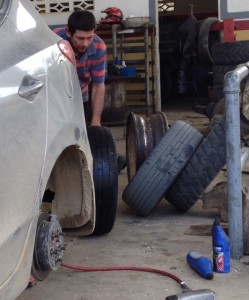From “Living in a Blue Zone” – a website dedicated to Dr. Michael Smith’s family adventures living in Nicoya, Costa Rica.
Blue Zone: An area in the world where people live measurably longer lives. In these regions, people reach the age of 100 at rates ten times greater than those in the United States. Currently, there are 5 Blue Zones. Dan Buettner researched these and discovered their secrets to longevity.
 At 8 o’clock this morning I stood next to our rental car as the kids were getting themselves loaded and ready for the drive to school. I finished putting the 1970’s throwback Styrofoam cooler with homemade water bottle ice packs (who needs those fancy gel packs, anyway?) and my reusable bags into the back of the car. I got in the car, looked at my husband and said, “Today is a success! No matter what else happens today, we can call it a success.” We did, after all, have four tires that were inflated and an engine that purred – well maybe not purred, but it started and was functioning.
At 8 o’clock this morning I stood next to our rental car as the kids were getting themselves loaded and ready for the drive to school. I finished putting the 1970’s throwback Styrofoam cooler with homemade water bottle ice packs (who needs those fancy gel packs, anyway?) and my reusable bags into the back of the car. I got in the car, looked at my husband and said, “Today is a success! No matter what else happens today, we can call it a success.” We did, after all, have four tires that were inflated and an engine that purred – well maybe not purred, but it started and was functioning.
You see, this past week on two separate occasions we discovered just minutes before school drop off departure time that we had a flat tire. This is not an uncommon occurrence here in Nosara where we drive on poorly maintained dirt roads riddled with potholes, ruts, and narrow one-lane bridges. The mystery is how we end up with nails and screws in our tires nearly event day. It’s natural here, and the local service station is well-equipped to handle the countless tire repairs. In ten minutes, one guy can get your tire fixed and the spare changed out for 2,000 colones. It’s only $4 – and it only happens in that 10 minute window if you’re lucky enough to be first in line. Otherwise, prepare to wait and wait and wait some more. You can’t book your calendar in 15-minute increments like we do in the United States. When your average road speed here in Nosara is 12 mph, you have to slow down. Everything takes longer – that’s just how it is. Don’t plan more than two errands in a day, or you’ll end up frustrated, and as the locals say, “Pura Vida.”
Unlike the United States, having a car in Costa Rica is a luxury. Most Costa Ricans cannot afford to purchase a car. Even the 1998 Toyota 4Runner with 250k miles on it that we purchased for $5,000 in the US would cost well-over $10,000 here. Cars really hold their value here, and nobody cares about the mileage! If it has four wheels and gets you where you need to go, well what more could you ask for? OK, maybe some air conditioning…
Toyota 4Runner with 250k miles on it that we purchased for $5,000 in the US would cost well-over $10,000 here. Cars really hold their value here, and nobody cares about the mileage! If it has four wheels and gets you where you need to go, well what more could you ask for? OK, maybe some air conditioning…
So, how do the locals get around? On foot, by bicycle, on a motorbike or by hitching a ride. We like to pick up hitchhikers when we have the room, as it’s just the right thing to do – and as an added bonus, we get to practice our rudimentary Spanish!
We feel truly lucky every time we climb into our dusty, dirty little car and can drive at a whopping 12 mph into town. Maybe one day in the near future we’ll get the call that our 1998 4Runner has cleared customs and is ready to roll. It’s been in the country for more than a month, and we haven’t been able to use it…but that’s another story. Pura Vida!

